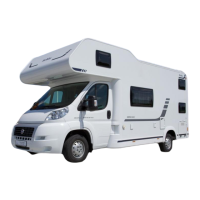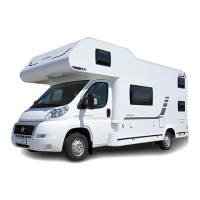03-3
1
2
3
3.2 Safety coupling
WS 3000
Preparation for hitching/unhitching
•
To hitch and unhitch, open the tension ball
coupler (lever in position
j
).
When dealing with higher drawbar
loads hitching and unhitching is
simplied by the use of a support
wheel.
Hitching
• The open tension ball coupler is set onto the
coupling ball of the base vehicle. The tension
ball coupler usually closes by applying down-
ward pressure since the support load is
suf-
cient (lever in position
k
).
WARNING: Ensure that the metal of
your ball coupler is bright and free of
grease.
Inspection of hitch
• The hitch is attached properly/closed if the
operation lever is in position
k
.
If the WS 3000 is not properly at-
tached to the coupling ball, the
camper
can detach from the base
vehicle.
The camper is equipped with an anti-rolling cou-
pling in accordance with ISO 11555-1. This safety
coupling stabilises the camper while driving and
ensures better driving performance.
Please note the additional operating instructions
and the manufacturer's safety instructions.
WARNING: The laws of physics
cannot be deed with a safety hitch.
If the limits (of speed and weight con-
ditions) are exceeded, traction and
cornering force are reduced, which
then becomes the responsibility of
the driver. Therefore,
avoid elevated
risks. Please take note of
the per-
mitted drawbar load for your base
vehicle.
If necessary, use drawbar load scales
to determine the approximate value
of the drawbar load for the camper.

